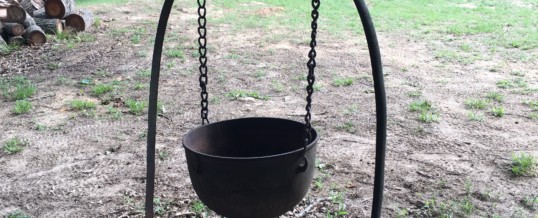
You’ve seen them. You may even own one. But, if you do, odds are you’re not using it for its intended purpose. I’m talking about cast iron wash pots. Also referred to as gypsy pots.
Many people call all of the large cast iron pots “gypsy pots,” but that’s like calling all soda pops a “Coke.” There is such a thing as a gypsy pot, but it’s different from a wash pot. Although, either can be used for just about anything.
If I’ve thoroughly confused you, let me try and explain a little better. I’m referring to the large cast iron pots that once were a common household item, but now are most often seen in someone’s front yard with flowers planted in them.
I was taught that a wash pot typically has a smooth, round rim, while what is called a gypsy pot has a lip around the rim. Think of a witches cauldron or kettle and you’ll have the right idea of what a gypsy pot looks like.
In America, the wash pot and gypsy pot are the two, large cast iron vessels with which we are most familiar. However, similar pots have been in use for hundreds of years all over the world. These types of pots, and other cast iron pieces, such as Dutch ovens and skillets, were once a family’s most prized possessions.
George Washington’s mother allegedly specified the recipients of her cast iron pieces in her will.
Prior to people having plumbing for running water in the home, many families, including my grandparents, had large cast iron pots that they used outside for everything from doing laundry, to cooking, to making lye soap.
They would fill the pot with water drawn from the well and then build a fire underneath the pot. The pot could serve as a laundry center one minute, then after being cleaned out and reseasoned, used to cook large quantities of food the next.
My grandmother had six kids, all born so close together (two of them being twins), that four of them were in diapers at the same time. Imagine standing over a pot of that laundry in July while running herd on six children. Think about the drudgery of a wash pot full of a never-ending supply of dirty clothes, a hot fire, a rub board, and a clothesline.
And we think that we have it rough when the washer or dryer goes on the fritz.
You might want to skip the next couple of paragraphs if you’re squeamish.
On the day that a hog was butchered, the wash pot turned into a vessel for making cracklings to eat, and rendering fat to make lye soap.
Today, we all can easily drop by the store and pick up boxes of laundry detergent, bars of soap, and bottles of shampoo. But our ancestors had to improvise and work hard for what they needed. When you have six kids and no air conditioning, soap and water are a necessity. Lye soap worked for laundry, bath soap, and shampoo.
I was told stories of how easily lye soap was made. You need fat, ashes, and water. I even remember being sung a song about, “Grandma’s Lye Soap,” although I don’t remember the words. But I do remember how lye soap was made.
You take the lard from a hog or tallow from a deer and render it over a fire. By the way, lard and tallow are just fancy names for fat.
While you’re waiting for the water to cook out of the fat, in a separate pot, you mix water with ashes you’ve saved from your fire and cook that down until the water is almost gone. I was told to only use ashes from hardwoods. So, yes to hickory or oak, and no to pine or sweet gum.
You strain the fat and ashes individually through a cloth into a jar and then mix the rendered fat and ashes into a mold. Let it set up and you can cut or break the finished soap into the sizes you want.
I’m not old enough to have witnessed the pots used in any of these ways. By the time I came along, most folks had indoor plumbing. So, my earliest memories of cast iron pots were of them being used as yard art. Most often, used as a large planter filled with flowers.
That’s exactly how the one that sat in my grandparents’ front yard was used. Sadly, my grandfather drilled a drain hole in the bottom of the pot. But, that was common 50 years ago after washing machines relegated wash pots to the yard. At least I know where mine cam from. Many people I know who have inherited wash pots don’t know for sure who the original owner was in their family. They just know that they wound up with it.
But, the good news is that with access to a sandblaster and a gas welder, you can take away any rust and weld the hole shut. Using a chain hoist and lots of Crisco or lard, you can coat and reseason the old wash or gypsy pots and return them to outdoor cooking or lye soap making.
That’s exactly what I plan to do with the one I inherited from my grandparents. Right now, it looks pretty rough, but if I can bring back an old wood stove that sat out in the weather for 30 years and rusted (which I did), I can do the same with that wash pot.
Notice that I said cooking and making lye soap? I omitted doing outdoor laundry. I’m nostalgic, but I’m not that nostalgic.
©2018 John Moore
John’s book, Write of Passage: A Southerner’s View of Then and Now, is available on Amazon. https://www.amazon.com/Write-Passage-Southerners-View-Then/dp/1548144983
Email John at John@TheCountryWriter.com.
JUN
2018
